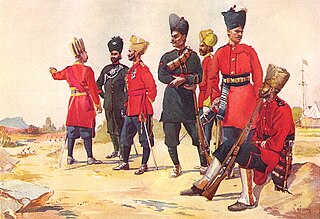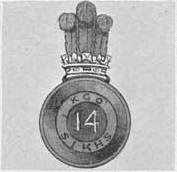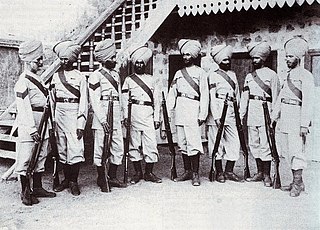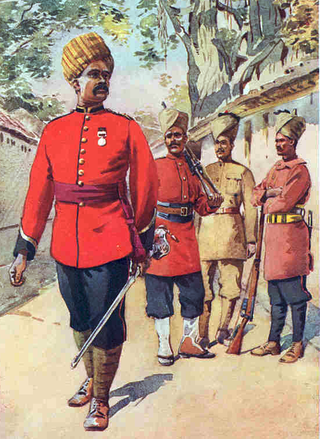
The 11th Sikh Regiment was an infantry regiment of the British Indian Army. They could trace their origins to 1922, when after World War I the Indian government reformed the army moving from single battalion regiments to multi battalion regiments. The regiment was formed from the:

The 119th Infantry (The Mooltan Regiment) was an infantry regiment of the British Indian Army. The regiment originated in 1817, when it was raised as the 1st Battalion, 10th Regiment of Bombay Native Infantry.

The 109th Infantry was an infantry regiment of the British Indian Army. The regiment traces its origins to 1768, when it was raised as the 5th Battalion, Bombay Sepoys.

The 104th Wellesley's Rifles were an infantry regiment of the British Indian Army. They could trace their origins to 1775, when they were raised as the 5th Battalion, Bombay Sepoys and presently its designation is 3 Guards of Indian Army.

The 13th Rajputs (The Shekhawati Regiment) was an infantry regiment of the Bengal Army, and later of the British Indian Army. They could trace their origins to the Shekhawati Regiment raised in 1835, as part of the Jaipur contingent of the Honourable East India Company and were taken into the Company's service as a local battalion 8 years later. They fought in the Battle of Aliwal in the First Anglo-Sikh War. Remaining loyal during the Indian Rebellion of 1857, they were taken into the Bengal Army as the 13th Bengal Native Infantry in 1861. There followed a number of different name changes the 13th (Shekhawati) Bengal Native Infantry 1884–1897, the 13th (Shekhawati) Rajput Regiment of Bengal Infantry 1897–1901, the 13th (Shekhawati) Rajput Infantry 1901–1903. Then finally in 1903, after the Kitchener reforms of the Indian Army the 13th Rajputs (The Shekhawati Regiment). During World War I they were part of the Imperial Service Infantry Brigade assigned to the Indian Expeditionary Force B that was sent to British East Africa. They fought at the Battle of Tanga, where although initially deployed in outdated formations, the regiment subsequently showed steadiness in street fighting with the defending German colonial troops.
The 7th Rajputs were an infantry regiment of the Bengal Army, later of the united British Indian Army. They could trace their origins to 1798, when they were the 1st Battalion, 24th Bengal Native Infantry. Over the years the regiment became known by a number of different titles. The 69th Bengal Native Infantry 1824–1828, the 47th Bengal Native Infantry 1828–1861, the 7th Bengal Native Infantry 1861–1883, the 7th Bengal Native Infantry 1883–1893, the 7th Rajput Regiment of Bengal Native Infantry 1893–1903 and finally after the Kitchener reforms of the Indian Army when the names of the presidencies were dropped 7th Rajputs. During this time the regiment took part in the First Anglo-Sikh War, the Second Opium War, the Sudan Campaign, the Boxer Rebellion and World War I. After World War I the Indian government reformed the army moving from single battalion regiments to multi battalion regiments. the 7th Rajputs now became the 3rd Battalion 7th Rajput Regiment. After India gained its independence this was one of the regiments allocated to the new Indian Army.
The 8th Rajputs was an infantry battalion of the British Indian Army. They could trace their origins to 1798 when they were the 1st Battalion, 30th Bengal Native Infantry. Over the years the regiment became known by a number of different titles. The 59th Bengal Native Infantry 1824–1861, the 8th Bengal Native Infantry 1861–1897, the 8th (Rajput) Bengal Infantry 1897–1901, the 8th Rajput Infantry 1901–1903 and finally the 8th Rajputs after the Kitchener reforms of the Indian Army. During this time the regiment took part in the First Afghan War, the First Sikh War and World War I. After World War I the Indian Government reformed the Indian Army again, moving from single battalion regiments to multi battalion regiments. The 8th Rajputs now became the 4th Battalion, 7th Rajput Regiment. After Indian gained independence in 1947, this was one of the regiments allocated to the new Indian Army.

The 11th Rajputs was an infantry regiment of the Bengal Army and later of the British Indian Army. They could trace their origins to 1825, when they were the 2nd Extra Battalion, Bengal Native Infantry. In 1828, they were renamed the 70th Bengal Native Infantry and a number of changes in name followed - the 11th Bengal Native Infantry 1861–1885, the 11th Bengal Infantry 1885–1897, the 11th (Rajput) Bengal Infantry 1897–1901, the 11th Rajput Infantry 1901–1903. Finally in 1903, after the Kitchener reforms of the Indian Army - the 11th Rajputs.

The 14th King George's Own Ferozepore Sikhs was a regiment of the British Indian Army; they can trace their origins to the Regiment of Ferozepore formed in 1846. The regiment had a number of different titles over the following years: the 14th Bengal Native Infantry 1861–1864, the 14th Regiment of Bengal Native Infantry 1864–1885, the 14th Regiment of Bengal Native Infantry 1885–1901, the 14th (Ferozepore) Sikh Infantry 1901–1903 and finally, after the Kitchener reforms of the Indian Army in 1903, the 14th Ferozepore Sikhs.

The 36th Sikhs was an infantry regiment in the British Indian Army. They could trace their origins to 1887, when they were the 36th (Sikh) Bengal Infantry. Composed of Jat Sikhs, it was created by Colonel Jim Cooke and Captain H. R. Holmes. They had one other change in title in 1901, when they became the 36th Sikh Infantry. They finally became the 36th Sikhs in 1903, after the Kitchener reforms of the Indian Army. During this time they fought an action in 1897, in defence of the Samana Ridge against a huge army of Pathans in the Battle of Saragarhi. To honour the visit of the Prince and Princess of Wales to India they took part in the Rawalpindi Parade 1905. During World War I they were stationed as part of the Garrison of Tianjin in China and took part in the Siege of Tsingtao.

The 23rd Sikh Pioneers were a regiment of the British Indian Army. They could trace their origins to 1857, when they were known as the 15th (Pioneer) Regiment of Punjab Infantry. The regiment recruited the Mazhabi Sikhs and Ramdasia Sikhs of Punjab province. Despite being Pioneers by name, the regiment was specially trained as Assault Pioneers.
The 43rd Erinpura Regiment was a regiment of the British Indian Army. It originated in the three infantry companies of Meena, Bhil tribe of the Jodhpur Legion that stayed loyal to the British when the Legion revolted in 1857.

The 34th Royal Sikh Pioneers was an infantry regiment of the British Indian Army. They could trace their origins to 1857, when they were raised as the Punjab Sappers.

The 35th Sikhs were an infantry regiment of the British Indian Army. They could trace their origins to 1887, when they were raised as the 35th (Sikh) Bengal Infantry.

The 45th Rattray's Sikhs was an infantry regiment of the British Indian Army. They could trace their origins to the 1st Bengal Military Police Battalion raised in April 1856, at Lahore, by Captain Thomas Rattray originally consisting of a troop of 100 cavalry and 500 infantry. The initial class composition of the troops was 50% Sikhs and 50% Dogras, Rajputs and Mussulmans (Muslims) from the Punjab and the North-West Frontier. It is said that he went through the villages challenging men to wrestle with him on the condition that they had to join up. Whatever the case, the regiment was raised and trained and developed as an elite corps, which soon saw action in Bihar in the Sonthal 'parganas'. After sterling service in Bihar, Bengal and Assam, and during the 1857 Mutiny, the cavalry portion was eventually disbanded in 1864 and the infantry section was taken into the line of Bengal Native Infantry as the '45th Native Regiment of Infantry'.
The 72nd Punjabis were an infantry regiment of the British Indian Army. They could trace their origins to 1759, when they were raised as the 16th Battalion Coast Sepoys.
The 74th Punjabis were an infantry regiment of the British Indian Army. They could trace their origins to 1776, when they were raised as the 14th Carnatic Battalion.

The 103rd Mahratta Light Infantry were an infantry regiment of the British Indian Army. They could trace their origins to 1768, when they were raised as the 2nd Battalion, Bombay Sepoys. The regiment was first in action in the Mysore Campaign during the Third Anglo-Mysore War, quickly followed by the Battle of Seedaseer and the Battle of Seringapatam in the Fourth Anglo-Mysore War. Their next action was at Beni Boo Ali against pirates in Eastern Arabia and the Persian Gulf region led the East India Company to carry out a punitive expedition in 1819 to Ras al Khaimah which destroyed the pirate base and removed the threat from the Persian Gulf.

The 110th Mahratta Light Infantry were an infantry regiment of the British Indian Army. The regiment traces their origins to 1797, when they were raised as the 2nd Battalion, 5th (Travancore) Regiment of Bombay Native Infantry.
The 121st Pioneers were an infantry regiment of the East India Company's Bombay Army and later the British Indian Army. The regiment traces their origins to 1777, when they were raised as the Marine Battalion.










